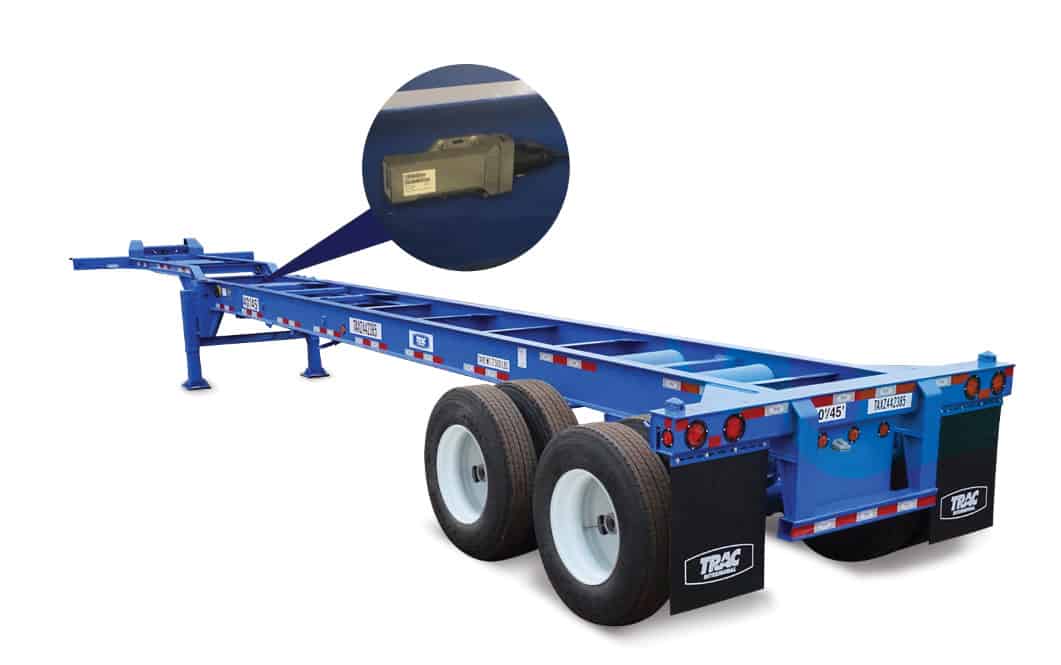Container chassis may be simple assets, but there is nothing simple about tracking their location throughout the U.S. supply chain.
Chassis providers and technology developers in recent years have chipped away at the challenge to electronically track usage of these assets with shippers, third-party logistics providers (3PLs), carriers, marine terminals and rail ramps.
“The problem is that there are many parties and systems involved when using chassis to dray containers,” Glenn Jones, global vice president of products and marketing for Blume Global, told American Shipper.
Blume’s solution tracks chassis by estimating per-diem and detention charges, then audits and reconciles invoices to validate charges, Jones said.
The U.S. container chassis business is unique to the rest of the world. In Europe and Asia, these assets are controlled by trucking companies. In the U.S., the majority of the estimated 500,000 chassis are controlled by a handful of leasing companies and pulled for use by truckers from pools at marine terminals and rail ramps.
“The process of matching orders to chassis and containers is still quasi-manual,” Jones said. “We’re still far away from fully tracking these assets.”
Promise of GPS
In recent years, GPS (global positioning system) has become one of the most promising technologies to track chassis in the U.S. supply chain.
American Intermodal Management (AIM), which merged with FlexiVan earlier this year, began attaching GPS sensors to its chassis in 2017, about a year after its formation by several former APL executives.

“AIM was founded with a belief that technology could expand the value of the chassis beyond its haulage functionality,” said AIM founder and FlexiVan Chief Operating Officer Than Seeds.
The GPS sensors installed on AIM’s chassis first provided the company, as well as its lease customers, with real-time geolocation, tire pressure and brake data.
“The merger of AIM and FlexiVan will allow us to more quickly scale our GPS-enabled asset network to reach more customers across a broader geography, customizing solutions to provide the data in a manner that is most helpful for their needs,” Seeds said.
FlexiVan currently has about 25,000 GPS-enabled chassis throughout the country. Seeds said the company is primarily focused on outfitting chassis with GPS for its leasing customers, such as shippers, truckers and freight consolidators. Since these lessees control the assets, they want to know where they are at all times, he added.
“We’re seeing an increase in customer interest for GPS-enabled equipment,” Seeds said. “The tracking benefits alone provide a compelling value even before we consider analytics benefits. Having real-time, automated information is of great value to network operators. It speeds decision-making.”
TRAC Intermodal, another large U.S. marine chassis provider, will equip leasing customer chassis with GPS technology provided through Spireon’s FleetLocate platform.
In addition to providing real-time tracking, GPS data provides TRAC’s chassis customers with mapping, geofencing, container mount and dismount details, and access to active and historical data. TRAC also uses solar panel technology to keep its GPS units charged.
U.S. chassis provider Direct ChassisLink (DCLI), which uses a variation of Blume’s chassis management tool as its own, will also enable chassis with GPS tracking, if requested by the lessee. (Both DCLI and Blume are owned by Apollo Global Management but operate separately.)
Pools pull at chassis IT
Chassis-tracking technologies within the pools remain limited due to the desperate number of drayage truckers hired by shippers, 3PLs and ocean carriers to pick up and drop off chassis.
Blume provides a form of chassis tracking in the pools through its technology that is triggered at the gates of marine terminals and rail ramps. Depending on the labor arrangements at these facilities, chassis pool checkouts and check-ins are performed manually or by radio-frequency identification tag readers.
Blume’s software allows chassis providers to know when a chassis leaves the pool, who is responsible for it, who is using it and when the asset returns. The arrival of the chassis back in the pool triggers Blume to generate the invoice, Jones said.

TRAC said it will provide GPS-based chassis tracking to dedicated chassis pools. For example, the company said it covers close to 75% of chassis with this technology in its ZIM Expedited Pool, which is a dedicated pool for the ocean container carrier’s eCommerce Xpress (ZEX) service.
In neutral chassis pools, however, TRAC uses EDI (electronic-data-interchange) data to track and manage this equipment.
“TRAC’s chassis inventory management is a complex system, designed to continually receive and interpret data from hundreds of our trading partners,” the company said. “This data, which includes chassis in-gate and out-gate information or the equipment roadability status is used by TRAC to track equipment and manage its pools’ inventory.”
However, TRAC sees current equipment tracking efforts within the U.S. just scratching the surface. The company said the growing complexity and demand for real-time data will require webhooks and APIs (advanced programming interfaces) within its EDI.
To facilitate technological developments, TRAC said it invests heavily in data science. In 2018, the company changed its data-management operation from a traditional model to a “next-generation data technology platform allowing TRAC to support its customers with real-time, actionable insight and agile decision-making.”
Related News
Ocean carrier group seeks dray truckers’ chassis complaint
US chassis providers stay on roll to radial tires
Q&A: US container chassis industry still finding itself
Click for more FreightWaves/American Shipper articles by Chris Gillis.

